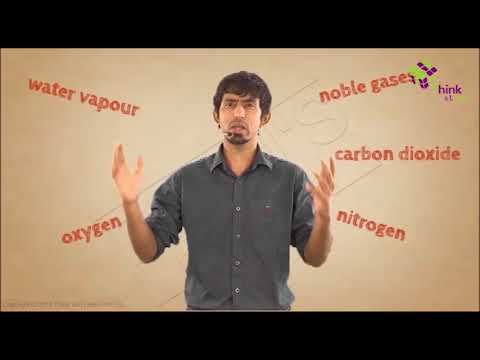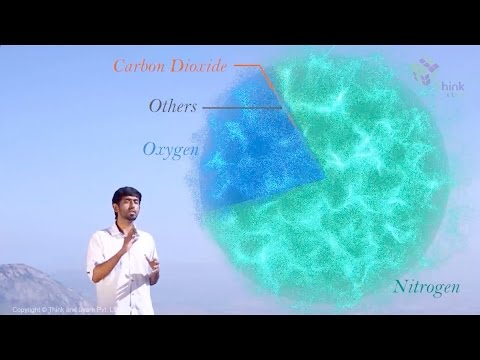Class 6 chemistry MCQs with answers are provided here for Chapter 15, Air Around Us. These MCQs are based on the CBSE board curriculum and correspond to the most recent Class 6 chemistry syllabus. By practising these Class 6 multiple choice questions, students will be able to quickly review all of the ideas covered in the chapter and prepare for the Class 6 annual examinations as well as other competitive exams.
Download Chapter 15 Air Around Us MCQs PDF by clicking on the button below.
Class 6 Air Around Us MCQs
1. The gas plants use for respiration is:
a.) Oxygen
b.) Carbon dioxide
c.) Nitrogen
d.) All of the above
Answer – (a.) Oxygen
Explanation – The diffusion process allows oxygen from the air to enter a leaf through the stomata and reach all cells. This oxygen is used in the respiration of leaf cells.
2. Which of the following components of air is harmful to living beings?
a.) Nitrogen and oxygen
b.) Carbon dioxide and water vapour
c.) Smoke and water vapour
d.) Dust and smoke
Answer – (d.) Dust and smoke
Explanation – Breathing in smoke and dust can enter our respiratory system (lungs) and harm our health.
3. Choose the incorrect statement from the following:
a.) Air is a mixture of gases.
b.) The composition of oxygen in the air is the maximum.
c.) The envelope of air that surrounds the earth is the atmosphere.
d.) Aquatic plants and animals use dissolved oxygen in the water.
Answer – (b.) The composition of oxygen in the air is the maximum.
Explanation – The major component of air is nitrogen.
4. Which of the following gases supports burning?
a.) Nitrogen
b.) Carbon dioxide
c.) Oxygen
d.) All of the above
Answer – (c.) Oxygen
Explanation – Nitrogen and carbon dioxide gases are neither combustible nor supporters of combustion. Only oxygen gas is required for combustion.
5. The gas breathed out by human beings and animals, which is used by plants is:
a.) Oxygen
b.) Carbon dioxide
c.) Nitrogen
d.) Water vapour
Answer – (b.) Carbon dioxide
Explanation – Oxygen is inhaled by human beings and animals, which is released by plants. Carbon dioxide, which is exhaled by human beings and animals, is used for photosynthesis by plants.
6. The major components of air are:
a.) Dust
b.) Oxygen
c.) Water vapour
d.) All of the above
Answer – (d.) All of the above
Explanation – Air is a mixture of gases. It contains water vapour, oxygen, carbon dioxide, nitrogen, dust, and smoke, among other things.
7. Oxygen and carbon dioxide are replaced in nature by:
a.) Photosynthesis
b.) Respiration
c.) Transpiration
d.) All of the above
Answer – (a.) Photosynthesis and (b.) Respiration
Explanation – Plants use carbon dioxide and sunlight to produce food, and in the process, they produce oxygen, which is released into the environment. Animals breathe in oxygen and expel carbon dioxide during respiration. Plants use oxygen for respiration as well. In nature, there is a balance of oxygen and carbon dioxide.
8. Which of the gases make up about 99% of the air?
a.) Oxygen and carbon dioxide
b.) Carbon dioxide and nitrogen
c.) Nitrogen and oxygen
d.) Nitrogen and ozone
Answer – (c.) Nitrogen and oxygen
Explanation – Air is made up of 78% nitrogen, 21% oxygen, and the remaining 1% of carbon dioxide, water vapour, dust particles, and other gases.
9. Which of the following is/are properties of air?
a.) Air occupies space
b.) Air is present everywhere
c.) Air exerts pressure
d.) All of the above
Answer – (d.) All of the above
10. The composition of nitrogen in air is:
a.) 78%
b.) 99%
c.) 88%
d.) 90%
Answer – (a.) 78%
Explanation – Air is composed of 78.% nitrogen, 21% oxygen, 1% of argon, carbon dioxide, and trace amounts of other gases.
11. The density of air ___ with height.
a.) Increases
b.) Decreases
c.) Remains the same
d.) First increases, then decreases
Answer – (b.) Decreases
Explanation – There is less air pushing down from above at higher altitudes, and gravity is weaker farther from the Earth’s centre.
12. On heating water, it is observed that bubbles come out from it. This concludes that:
a.) Water contains air
b.) Air contains water
c.) Water contains dissolved minerals
d.) All of the above
Answer – (a.) Water contains air.
Explanation – Water has dissolved air. When the water is heated, the air within it begins to escape, resulting in the formation of bubbles.
13. The moisture in air is called ____.
a.) Atmosphere
b.) Respiration
c.) Water vapour
d.) Humidity
Answer – (d.) Humidity
Explanation – The atmosphere is the layer around the earth, respiration is the process of breathing, and the amount of water vapour in the air is humidity.
14. Air is a ____ conductor of heat.
a.) Good
b.) Bad
c.) Sometimes good, sometimes bad
d.) None of the above
Answer – (b.) Bad
Explanation – Air is a poor conductor because, unlike a solid, its molecules are not in constant contact with one another.
15. Moving air is known as:
a.) Wind
b.) Breeze
c.) Ozone
d.) Water vapour
Answer – (a.) Wind
Explanation – Moving air is known as wind. Depending on their strength, winds can be known as a breeze. Ozone is a layer of the earth’s atmosphere.
16. Air is a ____.
a.) Compound
b.) Element
c.) Mixture
d.) Particle
Answer – (c.) Mixture
Explanation – A mixture is a combination of different things. Air consists of various gases like nitrogen, oxygen, carbon dioxide, etc. Therefore, air is considered a mixture.
17. The burning of fuels produces ____ gas.
a.) Oxygen
b.) Carbon dioxide
c.) Dust
d.) Smoke
Answer – (b.) Carbon dioxide
Explanation – Coal, petroleum, and natural gas are all examples of fossil fuels. When the hydrocarbons in the fossil fuel are burned, they produce energy and release carbon dioxide.
18. The oxygen gas is ____ than air.
a.) Lighter
b.) Heavier
c.) Has the same weight
d.) None of the above
Answer – (b.) Heavier
Explanation – Oxygen gas has a molecular weight of 32. As a result, it is heavier than air.
19. Mountaineers carry cylinders of which gas with them?
a.) Oxygen
b.) Nitrogen
c.) Hydrogen
d.) Carbon dioxide
Answer – (a.) Oxygen
Explanation – Mountaineers carry oxygen gas cylinders with them because oxygen is very less at higher altitudes.
20. The layer/blanket of air around the surface of the earth is called ____.
a.) Hydrosphere
b.) Stratosphere
c.) Atmosphere
d.) Lithosphere
Answer – (c.) Atmosphere
Explanation – The atmosphere helps to protect us against harmful ultraviolet solar radiation. The stratosphere is a layer of the atmosphere.
Hydrosphere is the total amount of water on a planet, and the lithosphere is the outer part of the earth.
Read Also:
- Air Around Us
- Components of Air
- Uses of Air
- Nitrogen
- Oxygen
- Carbon dioxide
- Class 6 Chemistry Worksheet Chapter 15 Air Around Us – Set 1
- Class 6 Chemistry Worksheet Chapter 15 Air Around Us – Set 2
- Class 6 Chemistry Worksheet Chapter 15 Air Around Us – Set 3
- Air Pollution Questions
- Chemistry Concept Questions and Answers
Recommended Videos
Introduction to the Components of Air

Composition of Air
